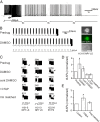Ivy and neurogliaform interneurons are a major target of μ-opioid receptor modulation
- PMID: 22016519
- PMCID: PMC3226788
- DOI: 10.1523/JNEUROSCI.2269-11.2011
Ivy and neurogliaform interneurons are a major target of μ-opioid receptor modulation
Abstract
μ-Opioid receptors (μORs) are selectively expressed on interneurons in area CA1 of the hippocampus. Fast-spiking, parvalbumin-expressing, basket cells express μORs, but circumstantial evidence suggests that another major, unidentified, GABAergic cell class must also be modulated by μORs. Here we report that the abundant, dendritically targeting, neurogliaform family of cells (Ivy and neurogliaform cells) is a previously unrecognized target of direct modulation by μORs. Ivy and neurogliaform cells are not only numerous but also have unique properties, including promiscuous gap junctions formed with various interneuronal subtypes, volume transmission, and the ability to produce a postsynaptic GABA(B) response after a single presynaptic spike. Using a mouse line expressing green fluorescent protein under the neuropeptide Y promoter, we find that, across all layers of CA1, activation of μORs hyperpolarizes Ivy and neurogliaform cells. Furthermore, paired recordings between synaptically coupled Ivy and pyramidal cells show that Ivy cell terminals are dramatically inhibited by μOR activation. Effects in Ivy and neurogliaform cells are seen at similar concentrations of agonist as those producing inhibition in fast-spiking parvalbumin basket cells. We also report that Ivy cells display the recently described phenomenon of persistent firing, a state of continued firing in the absence of continued input, and that induction of persistent firing is inhibited by μOR activation. Together, these findings identify a major, previously unrecognized, target of μOR modulation. Given the prominence of this cell type in and beyond CA1, as well as its unique role in microcircuitry, opioid modulation of neurogliaform cells has wide implications.
Figures




Similar articles
-
Ivy/neurogliaform interneurons coordinate activity in the neurogenic niche.Nat Neurosci. 2011 Oct 9;14(11):1407-9. doi: 10.1038/nn.2935. Nat Neurosci. 2011. PMID: 21983681 Free PMC article.
-
Expression of COUP-TFII nuclear receptor in restricted GABAergic neuronal populations in the adult rat hippocampus.J Neurosci. 2010 Feb 3;30(5):1595-609. doi: 10.1523/JNEUROSCI.4199-09.2010. J Neurosci. 2010. PMID: 20130170 Free PMC article.
-
A novel functionally distinct subtype of striatal neuropeptide Y interneuron.J Neurosci. 2011 Nov 16;31(46):16757-69. doi: 10.1523/JNEUROSCI.2628-11.2011. J Neurosci. 2011. PMID: 22090502 Free PMC article.
-
Ivy cells: a population of nitric-oxide-producing, slow-spiking GABAergic neurons and their involvement in hippocampal network activity.Neuron. 2008 Mar 27;57(6):917-29. doi: 10.1016/j.neuron.2008.01.034. Neuron. 2008. PMID: 18367092 Free PMC article.
-
Postsynaptic dopamine D3 receptors selectively modulate μ-opioid receptor-expressing GABAergic inputs onto CA1 pyramidal cells in the rat ventral hippocampus.J Neurophysiol. 2024 Dec 1;132(6):2002-2011. doi: 10.1152/jn.00353.2024. Epub 2024 Nov 21. J Neurophysiol. 2024. PMID: 39570291
Cited by
-
Cajal-Retzius cells and GABAergic interneurons of the developing hippocampus: Close electrophysiological encounters of the third kind.Brain Res. 2018 Oct 15;1697:124-133. doi: 10.1016/j.brainres.2018.07.028. Epub 2018 Jul 30. Brain Res. 2018. PMID: 30071194 Free PMC article. Review.
-
Opioid Receptor-Mediated Regulation of Neurotransmission in the Brain.Front Mol Neurosci. 2022 Jun 15;15:919773. doi: 10.3389/fnmol.2022.919773. eCollection 2022. Front Mol Neurosci. 2022. PMID: 35782382 Free PMC article. Review.
-
Characterization and mu opioid receptor sensitivity of neuropeptide Y interneurons in the mouse nucleus accumbens.Neuropharmacology. 2022 Nov 1;218:109212. doi: 10.1016/j.neuropharm.2022.109212. Epub 2022 Aug 10. Neuropharmacology. 2022. PMID: 35963449 Free PMC article.
-
Voltage-independent sodium channels emerge for an expression of activity-induced spontaneous spikes in GABAergic neurons.Mol Brain. 2014 May 20;7:38. doi: 10.1186/1756-6606-7-38. Mol Brain. 2014. PMID: 24886791 Free PMC article.
-
Feeding-modulatory effects of mu-opioids in the medial prefrontal cortex: a review of recent findings and comparison to opioid actions in the nucleus accumbens.Psychopharmacology (Berl). 2017 May;234(9-10):1439-1449. doi: 10.1007/s00213-016-4522-4. Epub 2017 Jan 4. Psychopharmacology (Berl). 2017. PMID: 28054099 Free PMC article. Review.
References
-
- Alle H, Geiger JR. Combined analog and action potential coding in hippocampal mossy fibers. Science. 2006;311:1290–1293. - PubMed
-
- Ascoli GA, Alonso-Nanclares L, Anderson SA, Barrionuevo G, Benavides-Piccione R, Burkhalter A, Buzsáki G, Cauli B, Defelipe J, Fairén A, Feldmeyer D, Fishell G, Fregnac Y, Freund TF, Gardner D, Gardner EP, Goldberg JH, Helmstaedter M, Hestrin S, Karube F, et al. Petilla terminology: nomenclature of features of GABAergic interneurons of the cerebral cortex. Nat Rev Neurosci. 2008;9:557–568. - PMC - PubMed
-
- Bellmann R, Widmann R, Olenik C, Meyer DK, Maas D, Marksteiner J, Sperk G. Enhanced rate of expression and biosynthesis of neuropeptide Y after kainic acid-induced seizures. J Neurochem. 1991;56:525–530. - PubMed
Publication types
MeSH terms
Substances
Grants and funding
LinkOut - more resources
Full Text Sources
Research Materials
Miscellaneous
